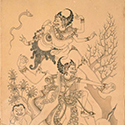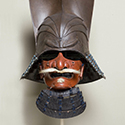|
|
| Show All 73 Results (Text Only) |
|
|
|
| Getting Started with Zazen (Seated Meditation) |
|
|
In Zen Buddhism, zazen (pronounced: zah-zen) is a sitting meditation. Zazen is not focusing on a specific object or thought. Instead, it is the liberating of one’s mind of all thought into a state of emptiness (a complete emptiness that is also complete fullness) from which the practitioner hopes to experience spontaneous awakening to the inner self (enlightenment). Download Includes a glossary.
Go to Museum Resource: https://education.asianart.org/resources/getting-started-with-zazen-seated-medi... | |
|
|
| Good and Evil? Dynamic Opposites in the Story of Rama |
|
|
Students brainstorm the qualities of good and evil and draw conclusions about the Balinese concept of “dynamic” or balanced opposites. Then, students will relate the idea of “dynamic opposites” in the Ramayana (Story of Rama) to present-day situations by identifying a current problem, creating a visual identify for their own pair of opposing characters, and scripting a dialogue. Downloads include lesson plans, activities, background and slideshow.
Go to Museum Resource: https://education.asianart.org/resources/good-and-evil-dynamic-opposites-in-the... | |
|
|
| Goryeo Dynasty: Korea’s Age of Enlightenment [PDF] |
|
|
Few people are aware that the name Korea is derived from the name of the Goryeo (previously tranliterated as Koryo) dynasty. It was during this period (918–1392) that Korea became known to the world outside East Asia. This packet provides an overview of aspects of Goryeo society and Goryeo Buddhism as depicted in the arts of the period.
Go to Museum Resource: https://education.asianart.org/wp-content/uploads/sites/6/2019/12/GoryeoDynasty... | |
|
|
| History and Traditions of the Samurai |
|
|
Students will use images of samurai armor and weaponry to learn related vocabulary. They will describe the functional and aesthetic aspects of armor through focused viewing and reading, and they will draw conclusions about the changing code of the samurai over the course of 800 years. Download includes a lesson plan, a number of guides, and slideshows.
Go to Museum Resource: https://education.asianart.org/resources/history-and-traditions-of-the-samurai/ | |
|
|
|
| How to Identify a Buddha |
|
|
"The earliest surviving representations of the Buddha date from hundreds of years after his death, so they are not portraits in the usual sense. Buddha images vary greatly from place to place and period to period, but they almost always show these conventional features..." Downloads includes student handouts and a teacher packet on Hindu Buddhist Art. See also An Introduction to Buddhism.
Go to Museum Resource: https://education.asianart.org/resources/how-to-identify-a-buddha/ | |
|
|
|
| Show All 73 Results (Text Only) |








